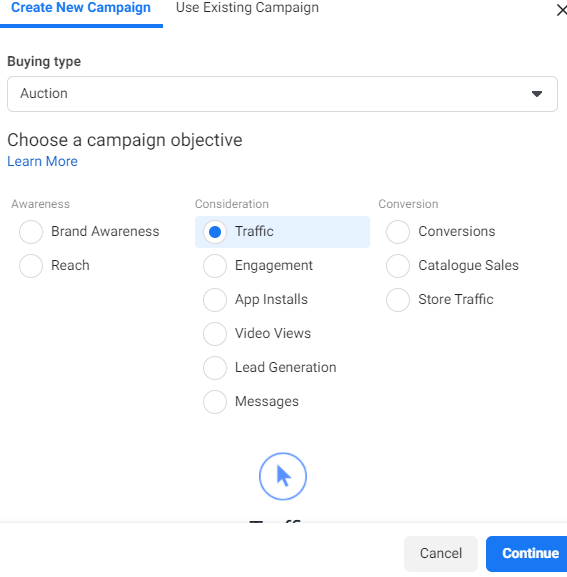Facebook continues to hold its position as a top tool prioritized by advertisers across various industries. With its low cost and ease of use, even new advertisers can start running Facebook campaigns immediately. However, many common Facebook ad mistakes can lead to unnecessary budget waste. In this article, learn how to avoid the 9 most common mistakes in Facebook advertising with this guide from Optimal Marketing Agency.
7 Common Facebook Ad Mistakes
With billions of users, advertising on Facebook can rapidly and effectively extend your brand’s reach. Reports indicate that businesses waste 25% of their advertising costs due to poor targeting and lack of campaign optimization.
Choosing the Wrong Advertising Objective
The first and most common mistake in Facebook advertising is selecting a goal that does not align with the campaign’s purpose.
Due to the vast audience, your customers only focus on a segment interested in your product. If the campaign targets too many irrelevant audiences, the budget will not be allocated correctly to achieve the desired results.

For example, if you are running a Facebook ad to sell fertilizers for a store and want to drive clicks, selecting “Traffic” instead of “Conversion” or “Messages” as your goal would be a mistake. Traffic goals generally help increase your website’s visibility to readers, but they do not convert them into sales.
Boosting Posts instead of creating Facebook Ad Campaigns
If you spend a lot of time on Facebook, you’ve probably noticed the “Boost Post” option beneath posts on your business’s Facebook page. You click on it and think, “I’ve started advertising on Facebook.” But that’s not really the case.
Although Facebook suggests that boosting a post can help you reach millions of people, it’s best not to use this option. Your main goal is to drive sale. This setup will cause you to miss out on many advanced tools.
When you rely solely on boosted posts, you miss out on the advanced options in Facebook Ads Manager, such as precise audience targeting, custom placements, and optimized bidding strategies.
Targeting too big or too small of an audience
Another common mistake in Facebook advertising revolves around audience size. But why is identifying the right audience size so important?
If your audience is too small, you might struggle to fully utilize your ad budget, or your ads might appear too frequently to the same users, leading to Facebook ad fatigue. On the other hand, if your audience is too large, you risk spending more money to reach people who might not be interested in your offer, reducing the effectiveness of your ads.
While there is no one-size-fits-all rule for the perfect audience size, it largely depends on factors such as your campaign goals, industry, and budget.
Failing to Control Your Budget
With Facebook ad, you must decide how much you want to spend on your ads. However, many businesses make the mistake of not controlling their budgets.
This mistake has two main parts that affect the effectiveness of your ad spending:
- Not setting a specific budget
- Not monitoring and adjusting bids and budgets
Without a fixed budget, you risk overspending because there’s no limit to control your ad spending and ensure long-term sustainability. Even with an initial budget, neglecting to adjust bids can lead to inefficient spending or missed opportunities to optimize performance.
Failing to research your ad target audience
If you don’t understand who your target audience is, what they care about, or their challenges, trying to reach the right people with your ads can be like finding a needle in a haystack.
Your ads might reach people who aren’t interested, leading to low engagement and wasted ad spend. This oversight can result in poor targeting settings, irrelevant messaging, and ultimately lower return on ad spend.
For example, individuals looking to buy fertilizers in Vietnam are mostly aged 30 and above, living in areas with ample land rather than in city centers like Hanoi or Ho Chi Minh City. Identify key characteristics of your target audience, including demographic information (age, gender, location) and psychographics (interests, behaviors, pain points) to create a clear customer profile.
Redirecting to an Irrelevant Landing Page
This Facebook ad mistake is quite common on other paid advertising platforms like TikTok, Google, etc.
No matter how much effort you put into creating a great ad, ultimately, sales happen on the page where you direct your ad traffic. If your landing page doesn’t match your ad, it can confuse visitors.
And when people are confused, they are unlikely to take the desired action. Ensure that your ad and landing page are perfectly aligned in terms of visuals, fonts, colors, and purpose—everything should be in harmony!
Ineffective Ad Ideas
Some advertisers believe that as long as the message is clear, the quality of the ad doesn’t matter. Ads that are too realistic or have too much long-winded text often fail to motivate customers to buy products. Low-quality and low-resolution images reduce attention-grabbing potential and can even lead to Facebook penalizing the ad, reducing its reach.
Currently, social media platforms are increasing the trend of copying other people’s creative ideas to gain profit.

Test too many Facebook ad elements
Another common mistake in Facebook advertising relates to ad testing. When monitoring your campaigns, you might notice areas that need improvement, leading you to make multiple adjustments simultaneously to test their overall impact.
The issue with this approach is that it prevents you from understanding the impact of each individual change. If your ad performs better, you won’t know which adjustment contributed to the improvement.
How to avoid Facebook Ad Mistakes?
Prevention is better than cure!
It’s always better to avoid mistakes from the start rather than trying to fix them later when your budget is drained, and your ad effectiveness has decreased.
Preventing Facebook ad mistakes starts with a solid foundation and a proactive approach. Here are some tips to help you avoid common pitfalls and maximize the effectiveness of your Facebook ads from the beginning:
- Clearly Define Your Goals: Start by setting specific, measurable goals for each campaign, such as brand awareness, lead generation, or conversions.
- Thoroughly Research Your Target Audience: Understanding who your ideal customers are, what they care about, and their online behaviors is key to successful targeting.
- Set a Realistic Budget and Monitor Closely: Establish a budget that reflects your goals and audience size, and keep track of your spending. Regularly monitoring your ad spend ensures you maximize ROI and can make adjustments as needed.
- Test and Optimize Regularly: Instead of making multiple changes at once, test one element at a time to understand what works best. Conduct A/B testing to see which creative, audience, or format delivers the best results.
- Track Performance Metrics: Keep an eye on key metrics like CTR, conversion rates, and ROAS.
In Conclusion
In summary, avoiding these common Facebook advertising mistakes can make a significant difference in the success of your campaigns. I hope this guide has provided you with valuable insights and actionable steps to enhance your Facebook advertising efforts and achieve your marketing goals.
